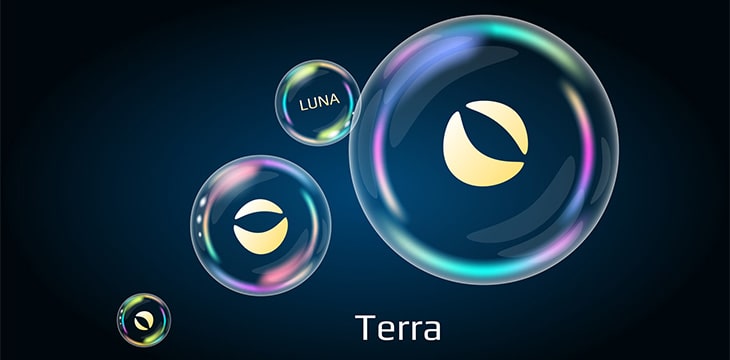|
Getting your Trinity Audio player ready...
|
Minting unbacked stablecoins while hoping that there won’t be a big influx of withdrawals—that’s the financial model of the biggest centralized stablecoin, $77 billion valued Tether’s USDT. Minting LUNA-backed stablecoins while hoping that there won’t be a big drawdown of LUNA price—that’s the financial model of the biggest decentralized stablecoin, $10 billion valued Terra’s UST.
UST, originally created to withstand up to 91% of the decline in value of LUNA (according to Terra white paper), has now deviated from its core goals of remaining safe and solid. The reason? Terra governance prefers big returns on stablecoin yield farming, not the stability of the ecosystem.
~65% LUNA decline could toast UST & the whole Terra ecosystem
The majority of the digital currency industry had to face a price decline of approximately 90% during the bear market of 2018-2020, and there is a good probability of a similar decline in the near future. Will it be enough to take down the whole Terra ecosystem? Absolutely.
Just two months back, only $3 billion worth of UST was in circulation. However, newly developed platforms like SPELL’s Magic Internet Money (MIM) promoted the concept of taking bigger risks to earn high APY on stablecoin farming, making Terra mint more UST while hoping that LUNA won’t go down a lot.
Two months back, UST’s total valuation was 12% of LUNA’s total market cap (which indicates that UST would be totally fine as long as LUNA’s decline remain less than 88%). Today, UST is 36% of LUNA’s total market cap. Once LUNA begins to decline in value and comes close to UST’s market cap, there is a very good chance that people could start panic selling their UST as well as LUNA, and resultantly not only break the peg but also the whole Terra ecosystem (for example, the Mirror Protocol, a platform built on Terra that deals in synthetic stocks, has US$1 billion worth of locked UST and it could go bankrupt with the UST collapse).
Interestingly, even Rune Christensen, the co-founder of MakerDAO, termed UST and MIM as “solid ponzis”:
Look, UST and MIM are solid ponzis and I respect that. You can make good money off them for sure. But they are not built for resilience and they are going to 0 once the market turns for real
Now stop trying to scam users looking for actual stability into being ur exit liquidity
— Rune (@RuneKek) January 4, 2022
Digital currency industry needs algorithmic stablecoins, but with stable infrastructure
With Gary Gensler finally gaining full authority over the regulation of the stablecoins, the U.S. Securities and Exchange Commission (SEC) can now regulate the stablecoins like USDT and USDC however they like. Apart from regulating the companies behind the stablecoins, this gives SEC the permission to blacklist any address holding any stablecoin.
The possible damage of this authority can be thought of this way: MakerDAO’s DAI token (pegged to $1) is mostly backed by USDC and ETH collateral. The SEC can simply order Centre, the company behind USDC, to use their blacklist(ethereum address) function and blacklist DAI’s USDC collateral. What happens next? Either MakerDAO’s governance allows additional ETH collateral liquidations to keep the peg intact or DAI loses its peg.
Although algorithmic (or decentralized) stablecoins make up for less than 2% of the digital currency industry’s market capitalization. It should be noted that in the event the SEC cracks down on industry, these algorithmic stablecoins can play an important role in the future and eventually gain much bigger market share. However, algorithmic stablecoins like UST and MIM are simply the solution for greed, not for the industry. The industry requires overcollateralized stablecoins, not undercollateralized ones.
Failures
Though algorithmic stablecoins are expected to become a major part of markets, it must be kept in mind that failures within such experiments (contract exploits, panic selling leading to liquidity crisis, or simply wrong algorithm) are quite common, and especially the newly introduced algorithmic stablecoins should be considered very risky.
In June 2021, the biggest algorithmic stablecoin failure happened due to the liquidity crisis of TITAN, which even affected Mark Cuban, the famous investor and billionaire. TITAN’s contract was exploited, and all of its liquidity was drained from the Uniswap pool. As the algorithmic stablecoin IRON which was backed by TITAN went to zero. This all may have happened because of a contract exploit, but it gives a strong message to the UST and Terra community; it’s all good only as long as your stablecoin collateral has available liquidity.
The numbers discussed in this article, such as market capitalizations, collateral ratios, etc., were taken at the time of writing.

 12-14-2025
12-14-2025 





